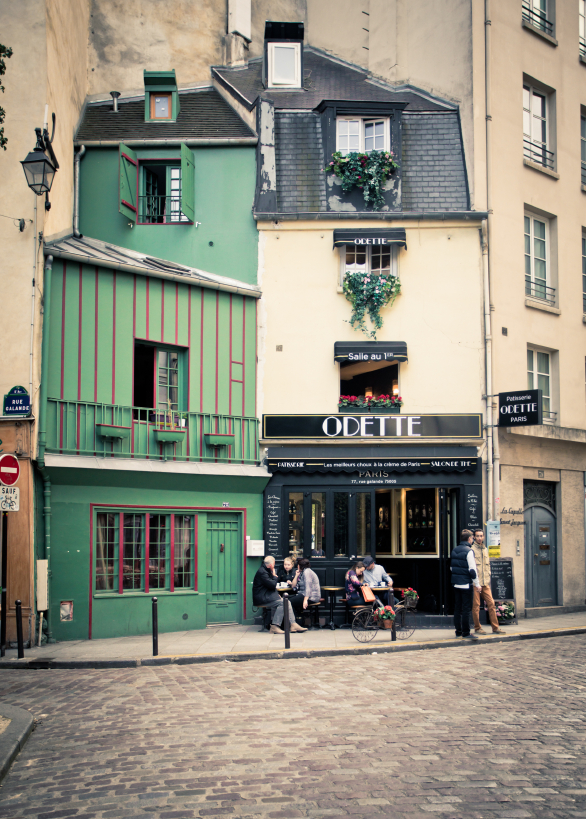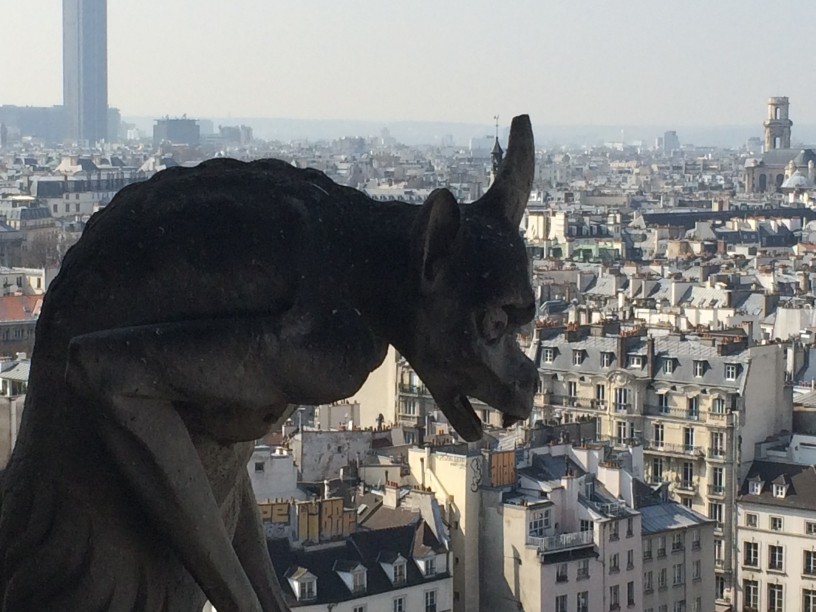I’ve been working on a general piece about Paris for months now, largely because I suspected I’d have nothing new to add to what’s already been said about this grand place, and this made me reluctant to commit. Finally I realized this: despite the reputation that precedes the City of Light, I arrived there relatively unaware of what specifically makes it so unique and beloved. I had only the vaguest ideas, things like: “The museums are so great!” “It’s so romantic!”…”Baguettes!” All of these enthusiasms do little to prepare a visitor for the experience of the city itself. Therefore, a great deal of this bucket-list destination surprised me. So although what I have to say about Paris may not be new to anyone else, Paris was new to me.
It’s true that there’s an abiding sense of elegance that no amount of pollution, gray skies, or dog droppings diminishes (and perhaps even enhances). Centuries of artistry are ubiquitous and prominent, and this craftsmanship remains vibrant and palpable, even though much of it is centuries old. The buildings along the Seine — such as the Musée d’Orsay, the Louvre, Notre Dame — felt like the heart of the city to me, creating an air of stately splendor, while also conveying, loud and clear, that What Has Been takes precedence over Whatever Will Be. Further reinforcing this idea is this: in Paris old age deepens beauty, imbuing it with luster and grace. Even decay is grand here, and somehow beautiful and right unto itself. This attribute alone may explain Paris’s appeal to Americans, with our culture of disposables, youth, and haste. Those of us who long for something lasting will discover a lot to relish in Paris. (I will not tackle the topic of beauty and age where women are concerned, as that is another matter completely.)
Despite all I’d heard about the famed rudeness of Parisians, I encountered this in only limited ways. Because every proprietor and shopkeeper is committed to greeting each customer (and in doing so looking you square in the face), there’s no avoiding a conversation. I found that if I returned their greeting, and smiled, I was very often offered a smile in return. And when leaving, there was without fail an “au revoir, merci” following me out the door.
I’d been warned that my attempts at speaking French would likely receive a response in English, and this was sometimes — but not always — the case. Service in bistros was uniformly friendly, and servers accepted my halting French, even graciously sometimes, though they often answered me in English. The friendliest of all Parisians that I encountered were the taxi drivers, who seemed happy to converse with me and asked me questions that I could actually understand and answer. Near the close of my stay, I had a full-on conversation with a cab driver, entirely in French — a real highlight and personal victory. And my meager grasp of the language did little to discourage the parting “au revoir, merci” of the shopkeepers, so conversations still ended with a degree of respect. This may be decorum; these words may mask an utter disdain. But manners are still manners, and in these small interactions, they made a big difference for my experience of the city.
Because I’ve read about the inefficiency of Parisian bureaucracy, I was pleasantly surprised at the efficiency of public transportation in Paris. In fact, I was deeply impressed, and thought on more than one occasion that they could teach us a thing or two. I was staying in the 7th arrondisement and could take a single bus all the way to Pere Lachaise Cemetery, on the other side of town completely, for 2 euros. This bus is nothing like those that run in San Francisco (“run” being a generous term, since SF Muni buses crawl through the congested streets, are notoriously off-schedule, and stop nearly every block for passengers). Parisian buses literally speed down boulevards and stop once every seven or eight blocks. They offer no right of way whatsoever to pedestrians encountered anywhere save the crosswalk of a major intersection, so they make excellent time getting wherever they are going, and the ride is pleasantly quick as a result. The metro is likewise a picture of efficiency and ease, though it is a bit intimidating to navigate a city that is basically unfamiliar. Trains run frequently and their routes cover the entire city, but stops are not spaced closely together (and Paris is vast); you will still need to do some walking. As with the buses, you must go to the transportation; it does not come to you. I found this idea — of responsibility to meet transportation, rather than entitlement to be met at your door by it — distinctly un-American, in the best of ways.
Which brings us to another thing I learned about Paris: it is huge. My first sightseeing day I decided to walk to Notre Dame from the 7th arrodisement, near the Eiffel Tower. While it’s true I was jetlagged, I arrived at my destination quite worn out from the walk, which took me a lot longer than I’d imagined it would. I’d been warned of this by my parents, who had been in Paris the year before and had told me their experience of walking to the Arc de Triomphe from the Louvre. What looked to be a twenty-minute walk turned out to be significantly longer, for two reasons: the blocks in Paris are long, and the Arc de Triomphe is enormous, appearing much closer than it actually is. I had a similar experience when I walked to the Musee d’Orsay. What I thought would be a 20 minute walk was 40 minutes, and once I reached the museum, I still had to circle its vast perimeter to find the entrance. And the Louvre! Well, I don’t even have words to describe how big it is.
Queues for everything are also very long, and very, very slow. I waited nearly an hour to purchase a drink at the Musée D’Orsay cafeteria, in a line of perhaps 15 people. (I may have underestimated haste when I spoke disparagingly of it above.) After an hour and a half, standing in the rain and on already aching feet, I was thrilled to ascend the spires of Notre Dame and look down upon this vast city, where I could easily see that in fact its size is part of what makes it so spectacular. And from up there, one is in such good company; the gargoyles and carbuncles scare away evils with their bulging eyes and gaping mouths, charming in their grotesqueness.
They are not the only ones presiding over the city, for the Musée D’Orsay is also beautifully adorned with a number of statues along its rooftop. I didn’t get the best picture of them, but here they are from inside the museum, near the marvelous clock:
Upon my return I was interrogated by others who have spent time in Paris: had I visited a far-flung neighborhood (especially after 11:00 at night)? Did I eat this dish at a most renowned bistro, being sure to order a bottle of such and such wine to accompany it? Did I view the piece de resistance at la musée extraordinaire? Had I crossed a particular “pont,” especially on a spring morning? When my answer was inevitably ‘no,’ the implication quickly became that if I hadn’t done these obligatory things, I hadn’t really EXPERIENCED Paris and therefore had somehow done the city and myself a disservice.
But I now understand that Paris is a place people claim as their own, as if it somehow must be possessed to be loved. Many who visit seem to end up thinking of it as their city, so sharing their memories of their own trips becomes an invitation to join them in their own marvelous time. I think the deeper truth here, though, is that Paris possesses us. Since my return, I’ve been asked to name highlights of my trip there, and the fact is, I can’t. It was all marvelous. Not every meal was spectacular, the weather was gray and overcast (though I happen to like this), it was crowded and hectic, and the queues for sites were outrageously long, slow, and cold. But I can’t wait to go back.






Recent Comments